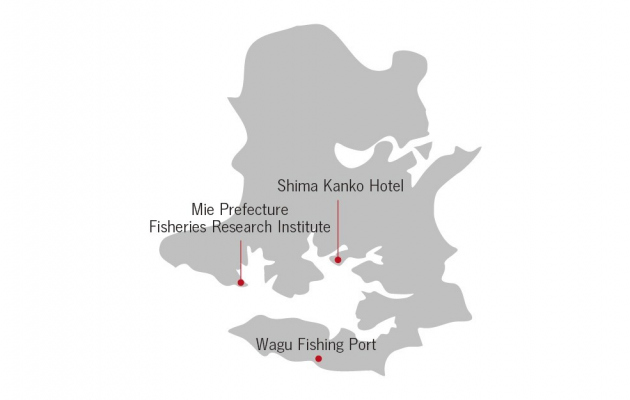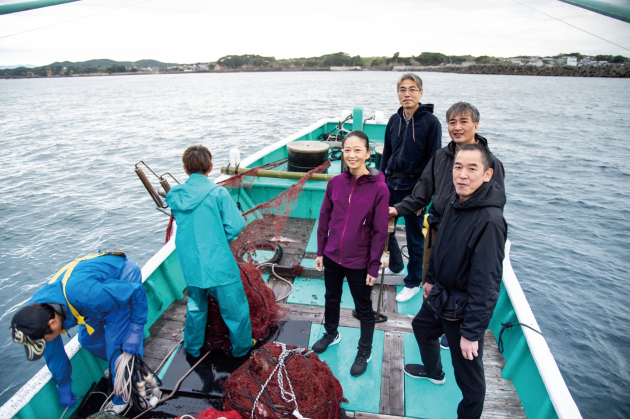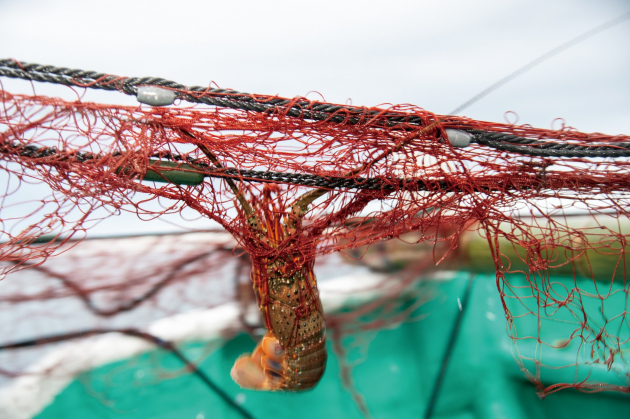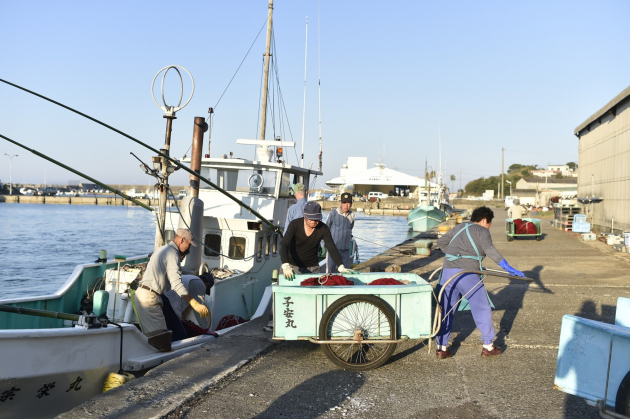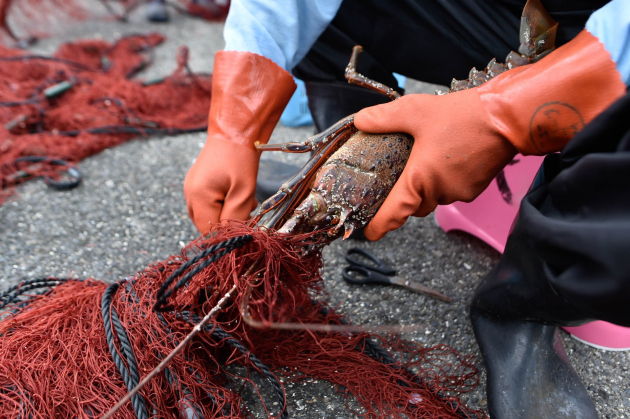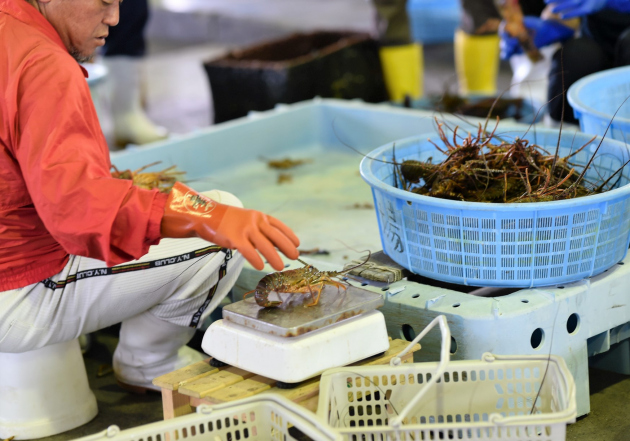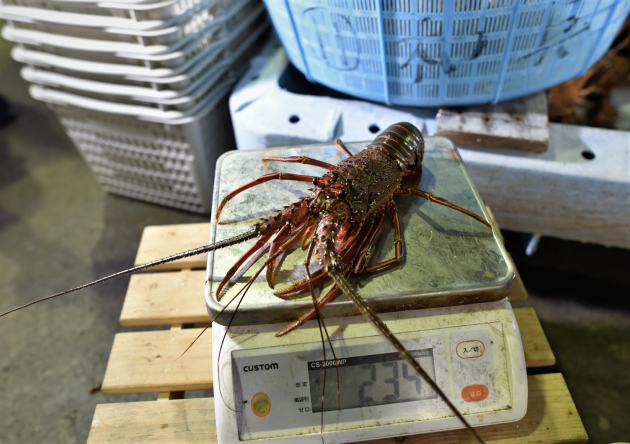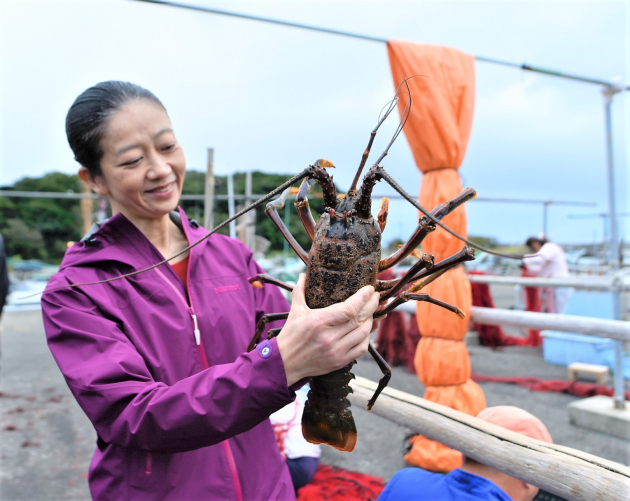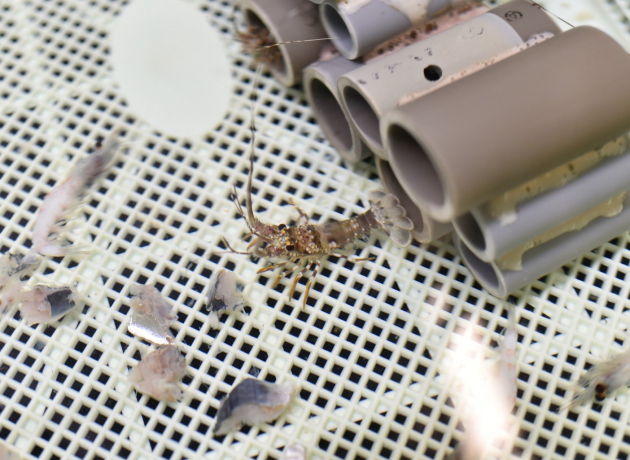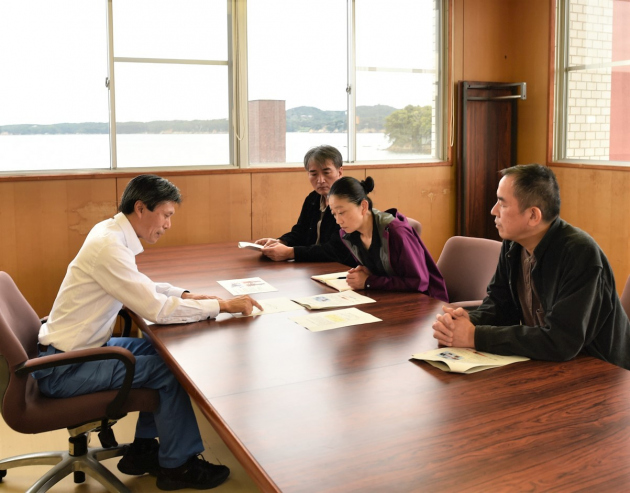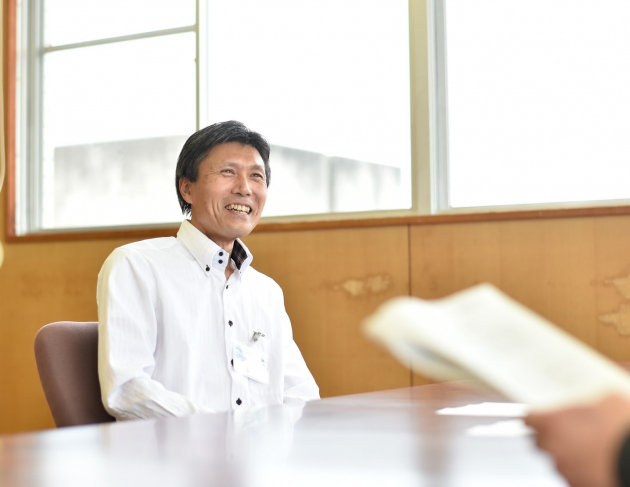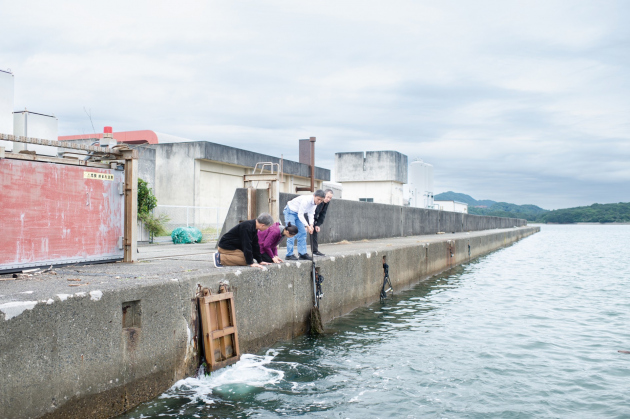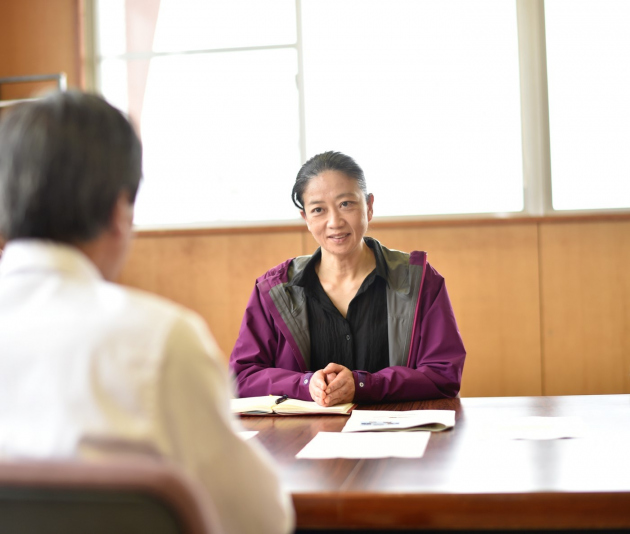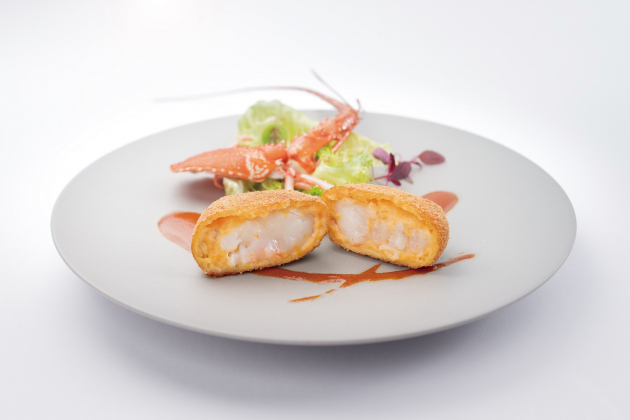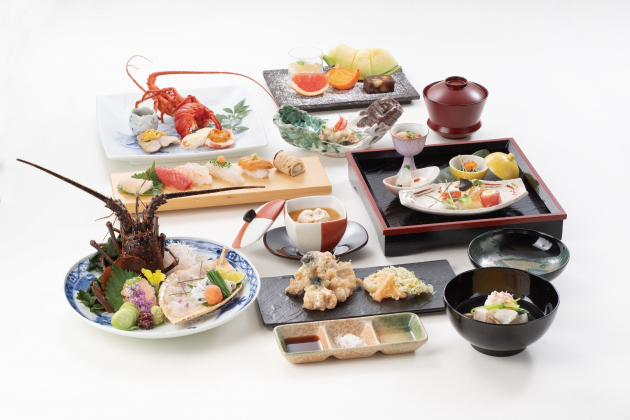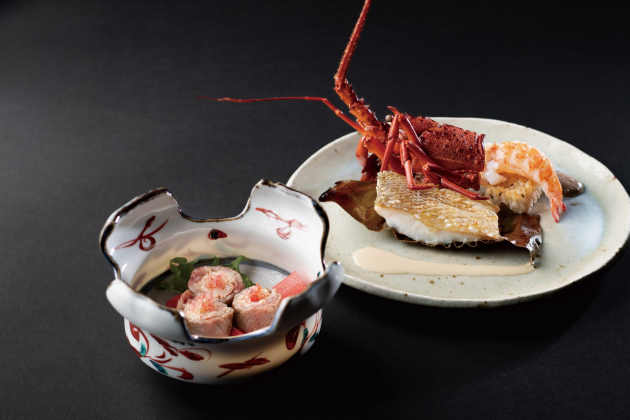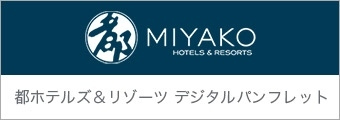Shima Peninsula’s Ise-Ebi (Japanese Spiny Lobster) and the Future
Shima Kanko Hotel’s seasonal magazine "Shima Time" introduces the four seasons of Ise-Shima through the local culture, rich nature, and food.
Ise-ebi, rooted in the life of a big production area.
From Shima Time Winter 2022 Issue
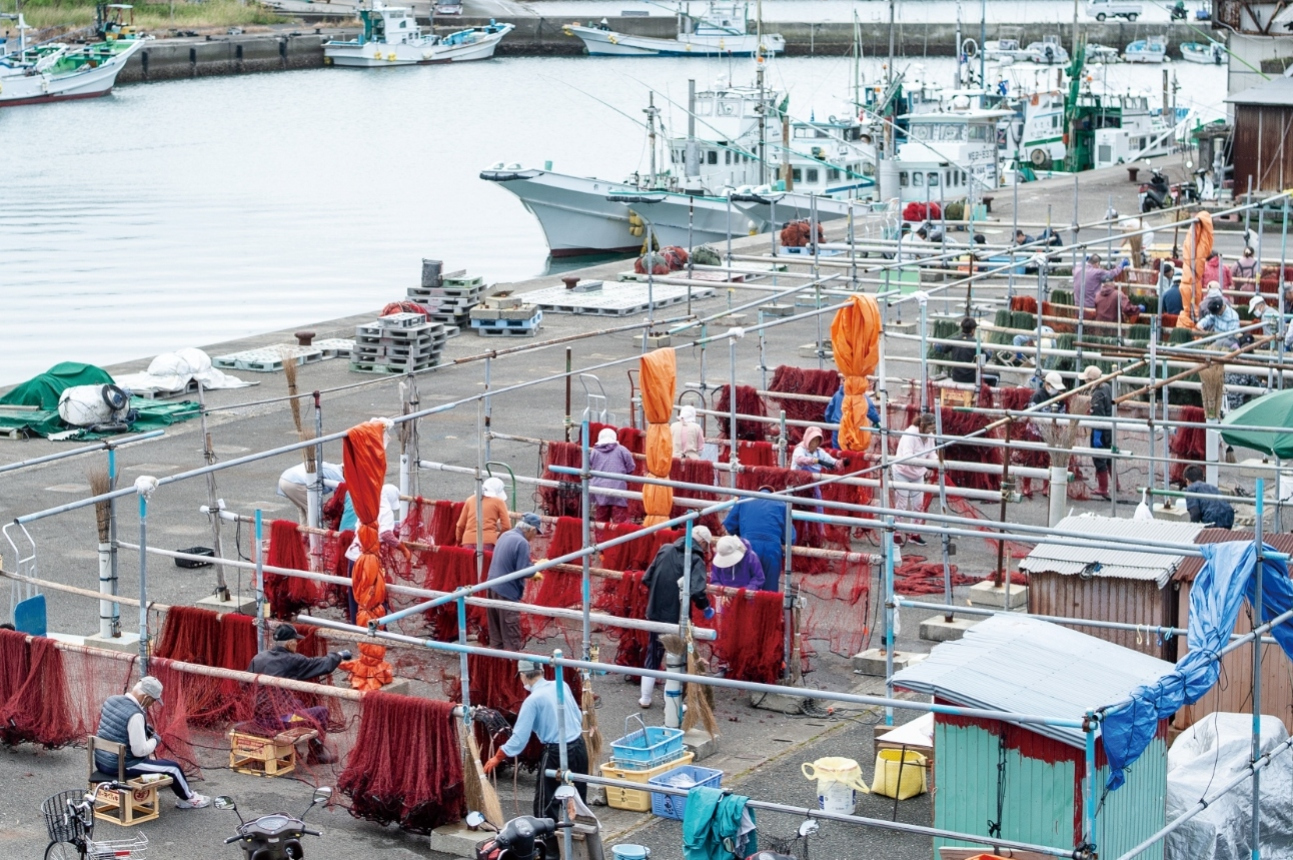
In October, when the Ise-ebi fishing season begins, the red lobster nets spread all over the fishing ports in Ise-Shima area bring us the feeling of winter. Ise-ebi is used as a seasonal word for the New Year in haiku (Japanese poem), and is an essential ingredient in celebratory dishes such as weddings and New Year's osechi (traditional New Year’s dish). It has also been certified as a “Fish of Mie Prefecture” and as a “Mie Brand.”
Mie Prefecture ranks first in Japan for catching the most Ise-ebi, and approximately 40% of them are caught in Shima City. Executive Chef Higuchi, Japanese Executive Chef Tsukahara, Head Chef Kurino, and Chef Sommelier Sugihara visited Wagu Fishing Port in Shima City, which is a major production area, and the Mie Prefecture Fisheries Research Institute, which has been researching Ise-ebi for 92 years. There was a ray of hope for those struggling to connect local industry to the future.
Ise-ebi, rooted in the life of a big production area.
Wagu in Shima City faces both Ago Bay and the outer bay where Ise-ebi fishing is carried out, and Wagu Fishing Port is one of the largest in the prefecture and is also popular for fishing other than Ise-ebi. There are currently 22 Ise-ebi fishing businesses in Wagu.
For Ise-ebi fishing, boats are set out in the afternoon of the previous day, while it’s still light, and the nets are set in fishing grounds, mainly shallow reefs about 10 minutes by boat. This is a fishing method called “gillnet fishing”, and after sinking the weighted nets with leads in the rocky area where the Ise-ebi lives, Ise-ebi will start moving around at night to search for food and get caught in the nets.
The fishing begins at dawn the next day, and the nets, each about 120 meters long, are slowly pulled up to avoid damaging the Ise-ebi. The maximum number of nets a boat can set is nine, and fishing ends when the net is raised from the point where it was set.
Returning to the port, the nets are unloaded from the boat one after another and transported to the net handling area on trolleys.
The Ise-ebi caught in the fully spread net are carefully removed by hand using special tools to prevent the legs and antennae from coming off. Because of the time and labor required, the entire family works together to remove the Ise-ebi from the nets. Sometimes the neighbors even come over to help.
What does Ise-ebi fishing mean to the people of Wagu?The fisherman said, “The town will become lively once the Ise-ebi fishing season is lifted. Of course, that makes me happy,” with a smile on his face.
A family doing the Ise-ebi removal from the nets also commented, “Although the amount is smaller than before, we look forward to getting together with everyone in the community to do the Ise-ebi removal from the nets together. It's our way of life,” they say calmly.
Ise-ebi are sorted by size and auctioned at the adjacent market. Mie Prefecture established the “Fisheries Adjustment Regulations” for Ise-ebi fishing, which prohibits catching Ise-ebi that weights less than approximately 70g.
However, Wagu has established its own rules that are even more stringent than that, and is working to conserve resources by releasing Ise-ebi even weighing less than 110g into the ocean.
Adapting to the changing times, the fishermen’s ceaseless efforts continue.

Mr. Ogawa and Executive Chef Higuchi talking about Ise-ebi
“Sometimes there are big prawns, and about 10 years ago, a pair of 2.5 kg Ise-ebi were caught together in the net. Its legs were thicker than the fingers of a human hand. They probably lived a long life by eating the abundant food.”
Everyone listening to the story looked surprised.
The Ise-ebi that are said to fetch a good price and be tasty are said to be around 200 grams.
Japanese Executive Chef Tsukahara says, “The reason why the Ise-ebi from the Shima Peninsula do not shrink easily even when cooked is because they are well fed and their meat is firm.”
Wagu has had a unique system called the “pooling system” since the 1970s. A special area is set aside for joint Ise-ebi fishing, and each fisherman’s family brings two nets each and rides on five boats to go fishing. The sales of the caught Ise-ebi will also be distributed fairly. Their efforts to protect the Ise-ebi resources by not over-fishing them and to ensure stable fishery management are attracting worldwide attention.
Head Chef Kurino explains, “Rising water temperatures reduces the amount of seaweed, which in turn reduces the amount of crustaceans and shellfish that the Ise-ebi feed on.”
Mr. Ogawa said, “Ise-ebi fishing is our livelihood, our life, and we are proud of our hometown where we were born and raised. So there’s no reason to be looking down. All we can do is to work together to figure out how to catch Ise-ebi and how to control the amount. I think we are in an era where we should not only seek profit, but also find the optimum quantity for catching. And I want to pass on the Ise-ebi fishing to the next generation.”
Chef Sommelier Sugihara said, “I was reminded once again of everyone's efforts to accept changes in the natural environment and the efforts of not giving up.”
Continuing to Explore Possibilities for the Future.
The Mie Prefecture Fisheries Research Institute located in Hamajima-cho, Shima City has been conducting research since 1930, and in 1988 they succeeded for the first time in the world in artificially raising young Ise-ebi from their eggs. Currently, research is being conducted to raise large numbers of young lobsters.
Ise-ebi hatch from eggs are called larvae when they are about 1.5 mm long, and then take a year to develop into young lobsters that are 2 cm long.
Researcher Shinji Tanaka says, “The problem with artificial rearing was that there was a lack of food such as shellfish during the period when the larvae were at their peak growth.”
Therefore, the research institute is experimenting by artificially controlling the spawning period of the parent lobster so that their growth coincides with the period when there is plenty of food.
“Even if a large number of young lobster can be raised and be released into the sea, if the seaweed beds are reduced due to rocky shore denudation, they will not be able to grow due to lack of food, which is a new problem, but it is believed that the Kuroshio Current that is affecting the sea environment will eventually subside.”
As the seawater temperature rises, the active period of seaweed-eating fish species becomes longer and the damage caused by feeding increases, so the research institute covers some of the seaweed with nets to protect it from feeding damage, and at the same time, a research that restores the marine environment by propagating the left behind seaweed when the seawater temperature drops is making progress.
“We measure the number of natural Ise-ebi larvae returning to the Shima sea every day. By analyzing these numbers, it is possible to predict the amount of Ise-ebi that will be ready to eat two to three years from now. I believe that it is the role of fisheries researchers to contribute to the environment and to the local life by linking information to planned fishing.”
Executive Chef Higuchi said, “Shortly after I joined the company, I had the opportunity to learn about Ise-ebi at this research institute. Since then, I had heard that the ecology of Ise-ebi was full of mysteries and that breeding was difficult, but after hearing today's story, I felt the efforts and hopes of the researchers from their steady progress.”
The passion for the region and the pride of a major Ise-ebi producing area are moving forward into the future.
| Executive Chef Hiroe Higuchi | Became Executive Chef at Shima Kanko Hotel in 2014 and took charge of the working dinner at the G7 Japan 2016 Ise-Shima Summit. Became the first woman and first person in Mie Prefecture to receive the Bronze Award Winner of 8th Annual Forestry and Fisheries Cooking Prize for "Cooking Masters" by Ministry of Agriculture, Forestry and Fisheries. |
|---|---|
| Japanese Executive Chef Kyoji Tsukahara | Refined skills at Miyako Hotel Osaka (now Sheraton Miyako Hotel Osaka) at Japanese restaurants "Miyako" and “Uemachi” from 1987. Involved in serving Japanese cuisine at the G7 Japan 2016 Ise-Shima Summit. Became Executive Chef of Japanese cuisine at Shima Kanko Hotel in 2019. |
| Chef Sommelier Masahiko Sugihara | Award winner in numerous competitions, including Semi-Finalist in the 2011 All-Japan Best Sommelier Competition. Served as Beverage Service Manager and Member of the Japanese Wine Selection Committee for the Ise-Shima Summit. |
| Head Chef of Bar Lien & Restaurant Yamabuki Masaya Kurino | Became Head Chef of Shima Kanko Hotel Teppanyaki Restaurant Yamabuki in 2020. Utilizing our extensive experience in the field, we offer teppanyaki where you can enjoy the conversation and the ambiance at the counter. |
Winter Dish Delivered by Executive Chef Hiroe Higuchi's Cooking Story
Villeroy style Ise-ebi
We express our gratitude to the Ise-ebi nurtured by the nature of the Rias coast of the Shima Peninsula and delivered with the efforts and pride of local fishermen.
Sauce Villeroy is made from white sauce base. This time, I added an American sauce with a rich shrimp flavor and flavored vegetables to bring out the star of the dish, the Ise-ebi. The surface of the raw Ise-ebi is coated with Villeroy sauce, shaped, battered and deep-fried. The texture of the crispy fried batter, the thick and piping hot sauce, and the half-cooked Ise-ebi.This is a dish that we would like you to enjoy the fascinating taste, and also the surprise when you eat it.
*May not be available depending on shipment conditions.
Ise-Ebi American Sauce
One of the hotel’s signature dishes is the “Ise-ebi American Sauce,” created by the previous Executive Chef Takahashi, who has a culinary philosophy of “Turns fresh through fire, turns natural through changing shape.” Our commitment to cooking live Ise-ebi after receiving an order remains unchanged.
The aromatic sauce and the flavor of the meat make this dish a masterpiece that further enhances the appeal of Ise-ebi. The symmetrical arrangement of Ise-ebi incorporates the beauty of ancient Japanese styles such as shrines and temples. Please enjoy a dish that can be said to be the origin of Ise-Shima gastronomy.
Ise-Ebi American Sauce ¥10,300
| French Restaurant "La Mer" | The Bay Suites 5F Dinner 17:30 - 21:00 (L.O. 19:30) *Some changes are currently in effect for our business hours |
|---|
Winter Dish Delivered by the Japanese Executive Chef Kyoji Tsukahara's Cooking Story
Ise-Ebi Steamed Hot Pot
Ise-ebi are a symbol of success in life and longevity, and are an indispensable ingredient for celebratory occasions, especially in Japanese cuisine. From a variety of cooking methods, we have prepared a steamed hot pot dish so that you can enjoy the original flavor of the Ise-ebi grown in the fertile sea.
You can fully enjoy the charm of Ise-ebi, which are indispensable as a good-luck charm.
Available at “Hamayu Kaiseki” (¥39,000) and at “Takumi” (¥50,000) from December to February.
*May not be available depending on shipment conditions.
*Unavailable dates: “Hamayu Kaiseki” 1/1-1/3, “Takumi” 12/31-1/3
Winter’s Miketsukuni Kaiseki
For Winter’s Miketsukuni Kaiseki, you can fully enjoy Shima’s natural Japanese pufferfish, which are in season, and Mie prefecture's brand fish Anori pufferfish and Ise-ebi.
The first dish is deep-fried fugu (pufferfish), which allows you to taste the flavor of the meat. We also add Ise-ebi to our miso soup, which is made with a special dashi stock to give it a rich flavor. For meals, you can choose from nigiri sushi, Ise-ebi tempura bowl, or Anori pufferfish porridge. Please enjoy the luxury of tasting a variety of flavors in the region where Anori pufferfish and Ise-ebi are produced.
Winter’s Miketsukuni Kaiseki
December 1st (Thursday) - February 28th (Tuesday), 2023
¥32,200
*Unavailable dates 1/1-1/3
| Japanese Restaurant "Hamayu" | The Bay Suites 4F Dinner 17:30 - 21:00 (L.O. 19:30) *Some changes are currently in effect for our business hours |
|---|
Winter Dish Delivered by Head Chef of Teppanyaki Yamabuki Masaya Kurino’s Cooking Story
Grilled Truffle Risotto with Ise-Ebi and Tilefish with Japanese Sake Sauce
A fusion of Japanese and Western essences, bringing out the charms of Ise-ebi and tilefish from Mie Prefecture.
Tilefish is covered with kelp, cooked from the skin, and steamed. Once the tilefish has the perfect aroma and flavor from the kelp, carefully remove the skin and grilled it in Matsukasa style. Please enjoy the difference in texture between the plump meat of the tilefish and the crispy skin.
Shallots and champignons are added to the fish stock, and the sauce is made with Japanese sake and fresh cream, giving it a sweet and rich flavor that is a little different from French white wine sauces. The head of the Ise-ebi is added to the miso soup at the end of the course for a comforting taste. We deliver a variety of textures, aromas, and tastes created from the iron plate.
From December to February, enjoy “a pairing dinner of fantastic Mie produce with winter flavors.”
¥64,400 for two people
*We will be providing a pairing Christmas dinner from 12/16 to 12/25.
| Teppanyaki Restaurant Yamabuki | The Club 2F (reservation required) Lunch 11:30 - 13:30 (L.O. 13:00/ Book by 20:00 2 days in advance) Dinner 17:30 - 21:00 (L.O. 19:30/ Book by 20:00 1 day in advance) *Some changes are currently in effect for our business hours |
|---|
Back to a list of feature stories
Shima Kanko Hotel’s Seasonal Magazine "Shima Time"
Alongside these changing seasons, the seasonal magazine "Shima Time" introduces the four seasons of Ise-Shima through the local culture, rich nature, and more.


